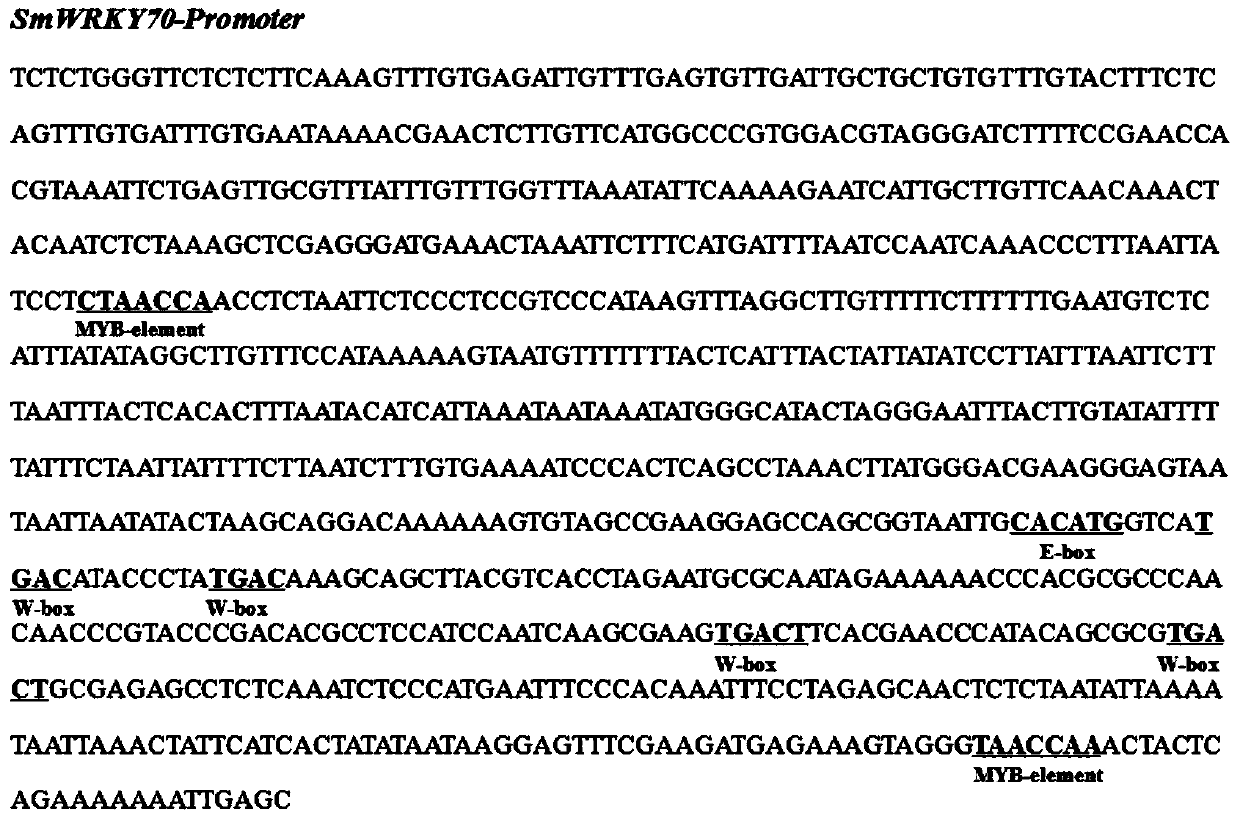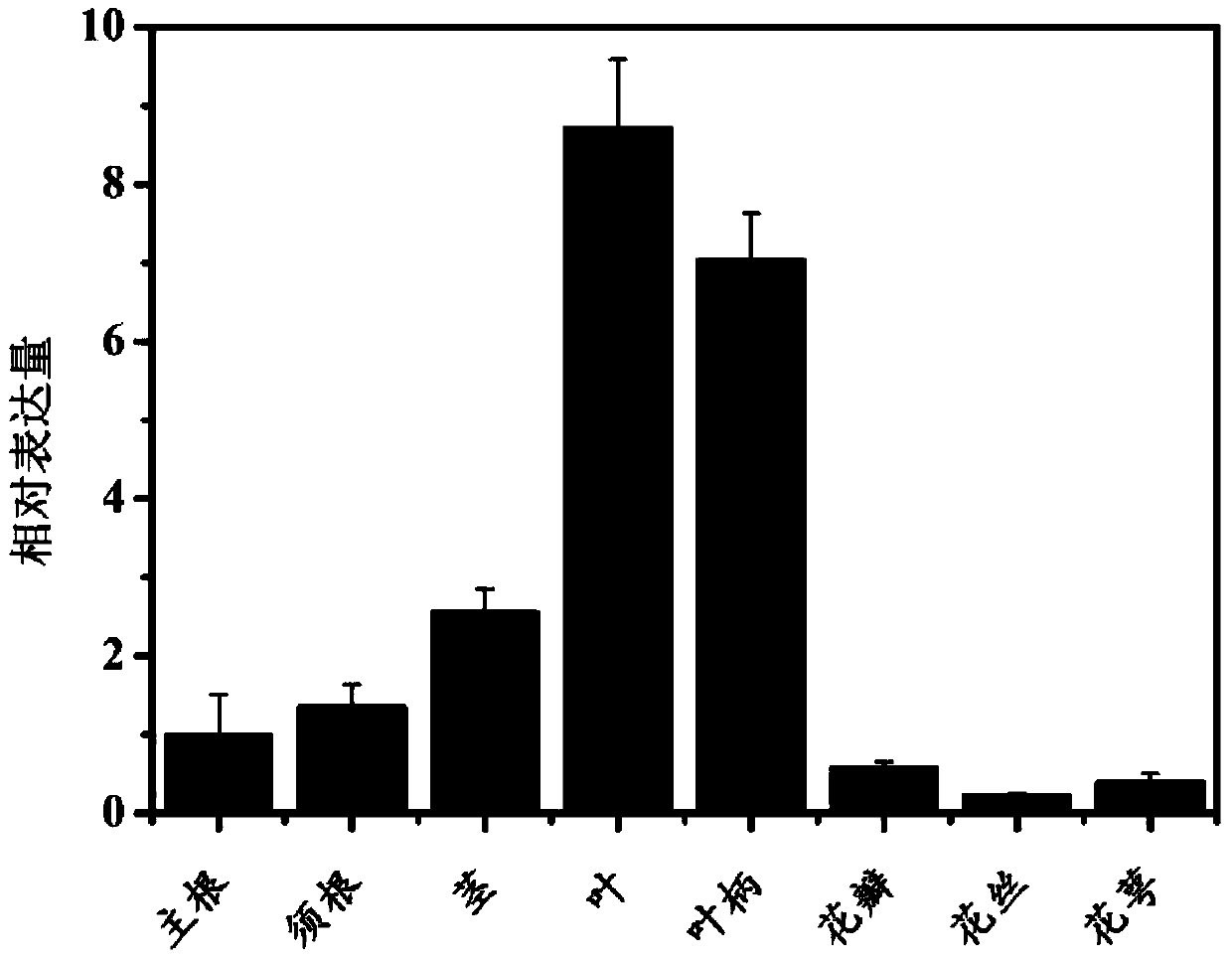A method for increasing the content of tanshinone in the hairy root of Salvia miltiorrhiza
A technology of tanshinone content and hairy roots, applied in the biological field, can solve undiscovered problems, achieve the effect of reducing drug prices and alleviating shortages
- Summary
- Abstract
- Description
- Claims
- Application Information
AI Technical Summary
Problems solved by technology
Method used
Image
Examples
Embodiment 1
[0025] Example 1: Cloning of Salvia miltiorrhiza SmWRKY70 gene
[0026] 1.1. Extraction of total RNA from Salvia miltiorrhiza
[0027] Take a small amount of young leaves of Salvia miltiorrhiza (produced in Pingyi, Shandong Province with a high tanshinone content) young leaves, quick-frozen with liquid nitrogen, and quickly grind them with a mortar, and then extract total RNA according to the instructions of the RNAprep Pure Plant Kit provided by TIANGEN company . The integrity of the RNA was detected by ordinary agarose gel electrophoresis (electrophoresis conditions: gel concentration 1.2%; 0.5×TBE electrophoresis buffer; 150v, 15min). The purity and concentration were detected with a Nano Drop 2000c ultra-micro spectrophotometer.
[0028] 1.2. Cloning of Danshen SmWRKY70 gene
[0029] Using the obtained 0.5 μg of Salvia miltiorrhiza as the initial amount, the first-strand cDNA was synthesized with reverse transcriptase XL (AMV) (for the operation steps, refer to the rele...
Embodiment 2
[0030] Example 2: Cloning of Danshen SmWRKY70 promoter
[0031] 2.1. Extraction of Danshen Genomic DNA
[0032] Genomic DNA of young leaves of Salvia miltiorrhiza was extracted by CTAB method, and the extracted DNA was subjected to gel electrophoresis to preliminarily confirm the integrity of the extracted DNA. The purity and concentration of DNA samples were detected by Nano Drop 2000c ultramicro spectrophotometer.
[0033] 2.2. Cloning of Danshen SmWRKY70 promoter
[0034] The LA PCRTM in vitro Cloning Kit (Code: DRR015) kit from TaKaRa Company was used to clone the SmWRKY70 promoter (for the operation steps, refer to the relevant instructions provided by TaKaRa Company). The extracted DNA was digested with restriction enzymes EcoR I, Pst I, and Bgl II for 6 hours, then recovered by ethanol precipitation, connected to the corresponding adapter in the kit, and recovered by ethanol precipitation 4 hours later. According to the known sequence of SmWRKY70, primer SmWRKY70-SP1 (S...
Embodiment 3
[0037] Example 3: Tissue expression profiling analysis of Salvia miltiorrhiza SmWRKY70
[0038] In order to study the tissue expression pattern of SmWRKY70, the total RNA of five tissues of root, stem, leaf, flower and seed of Salvia miltiorrhiza were extracted, and the purity and concentration were tested respectively. Then it was reverse-transcribed into cDNA and used for QRT-PCR analysis of the tissue expression profile of SmWRKY70. The reaction system used the SuperReal PreMix (SYBR Green) kit provided by TIANGEN Company, Actin was used as an internal reference gene, and the relative expression of the gene was calculated by the comparative CT method quantity. The results showed that SmWRKY70 was highly expressed in leaves and petioles, followed by higher expression in stems, and weaker expression in tap roots, fibrous roots, flowers, filaments, and calyx in all tissues tested (see image 3 ).
PUM
 Login to View More
Login to View More Abstract
Description
Claims
Application Information
 Login to View More
Login to View More - R&D Engineer
- R&D Manager
- IP Professional
- Industry Leading Data Capabilities
- Powerful AI technology
- Patent DNA Extraction
Browse by: Latest US Patents, China's latest patents, Technical Efficacy Thesaurus, Application Domain, Technology Topic, Popular Technical Reports.
© 2024 PatSnap. All rights reserved.Legal|Privacy policy|Modern Slavery Act Transparency Statement|Sitemap|About US| Contact US: help@patsnap.com










